D asystole b - Study guides, Class notes & Summaries
Looking for the best study guides, study notes and summaries about D asystole b? On this page you'll find 1348 study documents about D asystole b.
Page 3 out of 1.348 results
Sort by
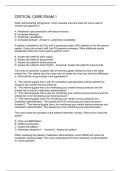
-
CRITICAL CARE EXAM 1
- Exam (elaborations) • 23 pages • 2024
-
- $12.99
- + learn more
When administering nitroglycerin, which possible outcome does the nurse need to monitor the patient for? A. Peripheral vasoconstriction with tissue necrosis B. Increased afterload C. Peripheral vasodilation D. Increased preload - Answer-C. peripheral vasodilation A patient is admitted to the ICU with a pulmonary artery (PA) catheter in the left internal jugular. During the nurse's shift, the PA pressure increases. What additional priority assessment does the nurse need to perform next?...
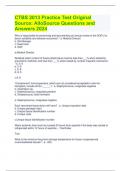
-
CTBS 2013 Practice Test Original Source: AlloSource Questions and Answers 2024
- Exam (elaborations) • 62 pages • 2024
-
- $12.49
- + learn more
Who is responsible for performing and documenting an annual review of the SOP's for donor suitability and adverse outcomes? - a. Medical Director b. QA Manager c. Supervisor d. Staff a.Medical Director Residual water content of freeze-dried tissue must be less than___% when tested by gravimetric methods, and less than ___% when tested by nuclear magnetic resonance. - a. 5, 6 b. 5, 8 c. 6, 8 d. 8, 5 c.6, 8 "Contaminant" microorganisms, which are not considered acceptable in s...

-
CEN PRACTICE TEST Q&A
- Exam (elaborations) • 16 pages • 2024
-
- $12.49
- + learn more
Preload refers to: a. The volume of blood entering the left side of the heart b. The volume of blood entering the right side of the heart c. The pressure in the venous system that the heart must overcome to pump the blood d. The pressure in the arterial system that the heart must overcome to pump the blood - Answer-b. The volume of blood entering the right side of the heart Preload is the volume of blood that enters the right side of the heart. This volume stretches the fibers in the he...
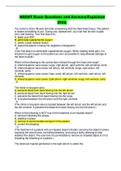
-
NREMT® EMR Exam Prep / NREMT Exam Questions and Answers/Explained 2022.
- Exam (elaborations) • 28 pages • 2022
-
Available in package deal
-
- $10.99
- 15x sold
- + learn more
NREMT Exam Questions and Answers/Explained 2022. You arrive to find a 48 year old male complaining that his chest feels heavy. The patient is awake and talking to you. During your assessment, you note that his skin is pale, cool, and clammy. Your first step is to: A. apply your AED B. administer supplemental oxygen C. obtain a past medical history D. assist the patient in taking his neighbor's nitroglycerin Which of the following is the correct flow of blood through the heart and lun...
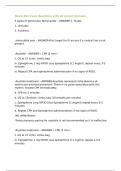
-
Sharp ESO Exam Questions with all correct Answers
- Exam (elaborations) • 25 pages • 2024
-
- $11.49
- + learn more
Sharp ESO Exam Questions with all correct Answers 3 types of Ventricular Tachycardia: - ANSWER-1. Stable 2. Unstable 3. Pulseless .antecubital vein – ANSWER-First target for IV access if a central line is not present .Asystole – ANSWER-i. CPR (2 min.) ii. O2 at 15 L/min. Ambu bag iii. Epinephrine 1 mg IVP/IO (use epinephrine 0.1 mg/ml), repeat every 3-5 minutes iv. Repeat CPR and epinephrine administration if no signs of ROSC .Asystole treatment – ANSWER-Asystole represents ...

-
AHA BLS Exam (Latest 2024/ 2025 Update) Questions and Verified Answers| 100% Correct| Grade A
- Exam (elaborations) • 18 pages • 2024
-
Available in package deal
-
- $10.99
- + learn more
AHA BLS Exam (Latest 2024/ 2025 Update) Questions and Verified Answers| 100% Correct| Grade A Q: Why is it important to compress to the appropriate depth during CPR? a. Adequate depth of compression is needed to create blood flow during compressions b. Adequate depth of compression is needed to create air flow into the lungs and adequate oxygenation c. Adequate depth of compression is needed to prolong asystole d. Adequate depth of compression is needed to stimulate spontaneous respiratio...
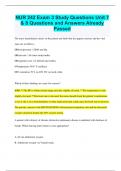
-
NUR 242 Exam 3 Study Questions Unit 7 & 8 Questions and Answers Already Passed
- Exam (elaborations) • 31 pages • 2024
-
- $10.49
- + learn more
NUR 242 Exam 3 Study Questions Unit 7 & 8 Questions and Answers Already Passed The nurse immediately checks on the patient and finds that she appears anxious and her vital signs are as follows: ØBlood pressure: 128/84 mm Hg ØHeart rate: 114 (sinus tachycardia) ØRespiratory rate: 24, labored and restless ØTemperature: 99.4° F (axillary) ØO2 saturation: 91% on 40% O2 via trach collar Which of these findings are cause for concern? ANS: **The BP is within normal range and only...
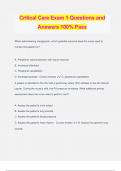
-
Critical Care Exam 1 Questions and Answers 100% Pass
- Exam (elaborations) • 42 pages • 2024
- Available in package deal
-
- $13.49
- + learn more
Critical Care Exam 1 Questions and Answers 100% Pass When administering nitroglycerin, which possible outcome does the nurse need to monitor the patient for? A. Peripheral vasoconstriction with tissue necrosis B. Increased afterload C. Peripheral vasodilation D. Increased preload - Correct Answer ️️ -C. peripheral vasodilation A patient is admitted to the ICU with a pulmonary artery (PA) catheter in the left internal jugular. During the nurse's shift, the PA pressure increases. Wha...
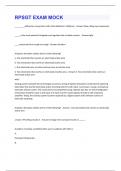
-
RPSGT EXAM MOCK QUESTIONS WITH COMPLETE SOLUTIONS GRADED A+
- Exam (elaborations) • 32 pages • 2024
- Available in package deal
-
- $7.99
- + learn more
_________defined as conjunction with initial deflection >500msec - Answer-Slow rolling eye movements _____is the most powerful zeitgeber and regulates the circadian system. - Answer-light ____measured from trough to trough - Answer-duration A bipolar derivation utilizes which of the following? a. One electrode that overlies an electrically active area b. Two electrodes that overlie an electrically active area c. One electrode over an active and one over an inactive area d. Two electrod...
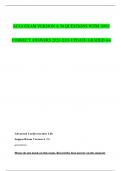
-
ACLS Exam Version A 2023/2024- 50 Questions and Answers
- Exam (elaborations) • 32 pages • 2023
-
- $22.99
- + learn more
You find an unresponsive patient who is not breathing. After activating the emergency response system, you determine that there is no pulse. What is your next action? A. Open the airway with a head tilt–chin lift. B. Administer epinephrine at a dose of 1 mg/kg. C. Deliver 2 rescue breaths each over 1 second. D. Start chest compressions at a rate of at least 100/min. 2. You are evaluating a 58-year-old man with chest pain. The blood pressure is 92/50 mm Hg, the heart rate is 92/min, the...

$6.50 for your textbook summary multiplied by 100 fellow students... Do the math: that's a lot of money! Don't be a thief of your own wallet and start uploading yours now. Discover all about earning on Stuvia


